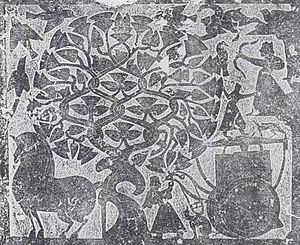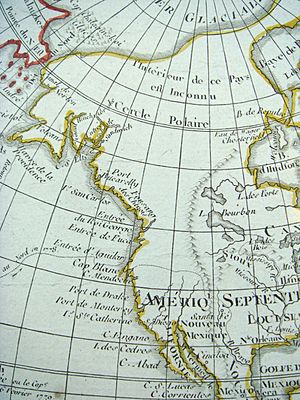Fusang facts for kids
Fusang (Chinese: 扶桑; pinyin: Fú Sāng) is a name used for different things, most often a mythical tree or a place far to the east of China. It is described in ancient Chinese writings.
In old books like the Classic of Mountains and Seas, Fusang refers to a legendary "tree of life." This tree was thought to grow far to the east of China. Some people believed it was a type of mulberry tree, while others thought it was a hibiscus. The name Fusang might also have been used for real places located east of mainland China.
In 499 AD, a Buddhist missionary named Hui Shen (Chinese: 慧深; pinyin: Huì Shēn) described a country called Fusang. He said it was 20,000 Chinese li (a measure of distance) east of a place called Da-han, and also east of China. Hui Shen traveled by ship to Fusang in 458 AD. When he returned in 499 AD, he told the Chinese Emperor what he had found. His stories are written in a 7th-century book called the Book of Liang.
People have wondered where Hui Shen's Fusang really was. Some thought it might be the Americas, while others suggested Sakhalin Island, the Kamchatka Peninsula, or the Kuril Islands. The idea that Fusang was America was very popular in the late 1800s and early 1900s. However, experts on China later showed that this idea was likely incorrect.
Contents
Mythical Journeys to Fusang
An old story says that in 219 BC, the emperor Qin Shi Huang sent about 3,000 prisoners on a journey. They were sent far across the ocean to a place called Fusang. Their mission was to make a sacrifice to a volcano god who was believed to hold the elixir of life. This elixir was thought to give eternal life.
The emperor's sorcerer, Xu Fu, led two trips to find this elixir. The first trip returned around 210 BC. Xu Fu claimed that a giant sea creature blocked their way. So, archers were sent to kill this monster for the second trip. However, the second expedition was never heard from again. Some records hint that Xu Fu might have returned to China and was just spending the expedition's money.
What Fusang Was Like
Hui Shen's report, found in the Book of Liang, gives us many details about Fusang:
Fusang was located 20,000 li (about 8,300 kilometers or 5,160 miles) to the east of a country called Dàhàn. It was also east of China.
On this land, there were many Fusang plants. These plants had oval-shaped leaves, similar to a paulownia tree. They also produced purplish-red fruits that looked like pears and were edible. The country had a lot of copper. It also had some gold and silver, but no iron.
The people living in Fusang were civilized. They lived in well-organized communities. They made paper from the bark of the Fusang plants for writing. They also made cloth from the plant fibers, which they used for clothes or padding. Their houses were built using red mulberry wood. The fruits and young shoots of the Fusang plants were part of their food.
The people of Fusang raised deer for meat and milk, much like the Chinese raised cattle. They even made cheese from deer's milk. They traveled on horseback and moved their goods using carts or sledges. These were pulled by horses, buffalo, or deer.
How the Country Was Organized
An emperor, or a main chief, ruled the country. He had the help of several officials. Most of the people followed the laws. The country did not have an army or military defenses. However, it did have two jails. One jail was in the north and the other in the south.
People who committed serious crimes were sent to the northern jail for life. Even there, they could get married. If they had children, their sons became slaves and their daughters became maids.
Social Customs in Fusang
Marriage was quite simple. If a boy wanted to marry a girl, he had to build a small cabin next to her home. He would stay there for a year. If the girl liked him, they would get married. If not, he would be asked to leave.
When someone died, their body was cremated. The time for mourning varied. People mourned for seven days if a parent died, five days for a grandparent, and three days for a brother or sister. During these mourning periods, people were not allowed to eat food. They could only drink water. The people of Fusang did not practice Buddhism at first.
Buddhism Comes to Fusang
The Book of Liang also tells how Buddhism came to Fusang. In 485 AD, five monks from Gandhara (a region near Kabul) traveled to Fusang by ship. They taught the Buddhist religion, shared scriptures, and encouraged people to let go of their worldly desires. Because of their efforts, the customs of the people of Fusang changed.
It is also said that 1,000 li (about 415 kilometers or 258 miles) beyond Fusang, there was a "Land of Women." Its female inhabitants were completely covered with hair. They walked upright and talked a lot among themselves. However, they were shy when they saw ordinary humans. They gave birth after six or seven months of pregnancy and nursed their babies on their backs. The babies could walk within 100 days and were fully grown in three or four years.
See also
 In Spanish: Fusang para niños
In Spanish: Fusang para niños



